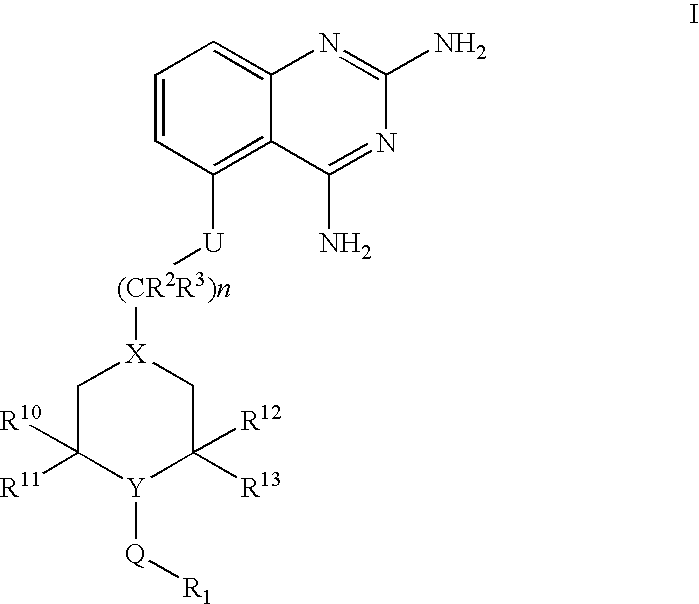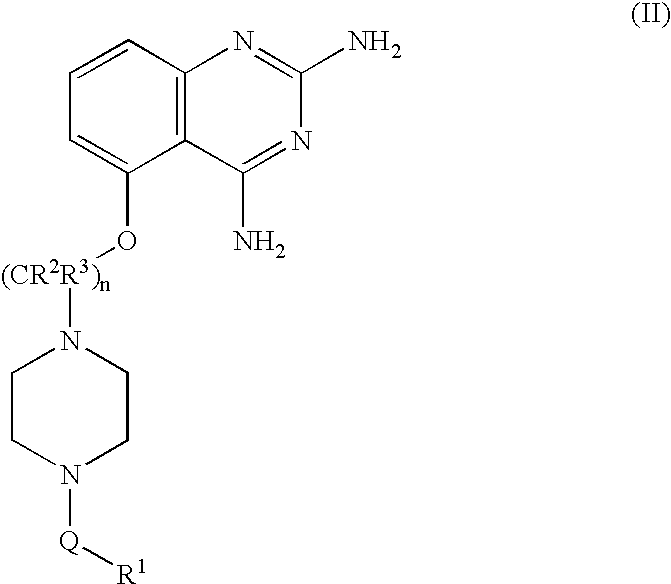2,4-diaminoquinazolines for spinal muscular atrophy
a technology of diaminoquinazoline and spinal muscular atrophy, which is applied in the direction of biocide, muscular disorder, drug composition, etc., can solve the problems of general weakness and wasting of voluntary muscles, floppiness of limbs and trunks, and general weakness of intercostal and accessory respiratory muscles
- Summary
- Abstract
- Description
- Claims
- Application Information
AI Technical Summary
Benefits of technology
Problems solved by technology
Method used
Image
Examples
example-1
[0125][5-(1-(2-Fluorobenzyl)piperidin-4-ylmethoxy]quinazoline-2,4-diamine (Method DD) (Example-001). To a mixture of 5-(piperidin-4-ylmethoxy)quinazoline-2,4-diamine (1.2 g; 4.4 mmol) and triethylamine (1.2 mL; 8.8 mmol) in 10 mL DMF was added 2-fluorobenzyl bromide (0.6 mL; 4.8 mmol) and stirred at 60° C. for 16 hours. Reaction was cooled to room temperature and concentrated at reduced pressure. Residue was taken up in 30 mL dichloromethane and 2 mL of methanol created a homogenous mixture. Material was purified via flash chromatography using a 5-10% MeOH / DCM with 0.1% NH4OH gradient. Material was then repurified by trituration with 1N NaOH and ethanol for 1.5 hours. Solids were collected by filtration to obtain title compound 740 mg (44% yield). 1HNMR (500 MHz, DMSO-d6) δ 7.40 (t, J=7.5 Hz, 1H), 7.31 (m, 1H), 7.18 (m, 3H), 6.77 (d, J=8.0 Hz, 1H), 6.52 (d, J=8.0 Hz, 1H), 5.98 (br s, 2H), 3.97 (d, J=6.0 Hz, 2H), 3.53 (s, 2H), 2.85 (br d, J=11.5 Hz, 2H), 2.01 (t, J=10 Hz, 2H), 1.84 (...
example-2
[0126]5-[1-(3-chlorobenzyl)-piperidin-4-ylmethoxy]-quinazoline-2,4-diamine (Example-002). To a stirred solution of 5-(piperidin-4-ylmethoxy)quinazoline-2,4-diamine (2.5 g, 9.15 mmol) and diisopropylethylamine (2.96 g, 22.87 mmol) in DMF (16 mL) was added a solution of 3-chlorobenzyl bromide in DMF (4 mL). The reaction mixture was heated at 60° C. with stirring for 20 h. The mixture was concentrated, water was added stirred for 1 h. The precipitate was filtered, washed with water, dried. Purified by silica gel column chromatography using 3-10% methanol in dichloromethane afforded 1.82 g of 5-[1-(3-chlorobenzyl)piperidin-4-ylmethoxy]quinazoline-2,4-diamine 1H NMR (400 MHz, DMSO-d6) δ 7.25-7.38 (m, 5H), 7.2 (s, 2H), 6.77 (dd, J=8.0, 1.2 Hz, 1H), 6.53 (dd, J=8.0, 0.8 Hz, 1H), 5.95 (s, 2H), 3.99 (d, J=6.4 Hz, 2H), 3.48 (s, 2H), 2.84 (d, J=11.2 Hz, 2H), 1.7-2.07 (m, 5H), 1.3-1.42 9m, 2H). MS m / z (ESI) 399 (M+H)+.
example-3
[0127][5-(1-(2-Chlorobenzyl)piperidin-4-ylmethoxy]quinazoline-2,4-diamine (Example-003). To a mixture of 5-(piperidin-4-ylmethoxy)quinazoline-2,4-diamine (1.0 g; 3.7 mmol) and triethylamine (1.3 mL, 9.2 mmol) in 10 mL N,N-dimethylformamide was added 2-chlorobenzyl bromide (0.5 mL; 3.7 mmol) and stirred at 60° C. for 16 hours. Reaction was cooled to room temperature and solvent volume was reduced by half in vacuo. Mixture was poured into 4 mL 1N NaOH and precipitated with an additional 15 mL water. Purification of filtered solids was reprecipitated from methanol and dichloromethane (2:1). Mixture was allowed to sit overnight. Solids were filtered off and rinsed once with methanol and twice with diethyl ether to yield title compound. (684 mg; 47% yield). 1 (400 MHz, DMSO-d6) δ 7.49 (d, J=7.6 Hz, 1H), 7.41 (d, J=7.6 Hz, 1H), 7.32 (m, 3H), 7.2 (br s, 2H), 6.76 (d, J=7.6 Hz, 1H), 6.53 (d, J=7.6 Hz, 1H), 5.94 (br s, 2H), 3.99 (d, J=6.0 Hz, 2H), 3.57 (s, 2H), 2.89 (m, 2H), 2.08 (t, J=12 Hz...
PUM
| Property | Measurement | Unit |
|---|---|---|
| pH | aaaaa | aaaaa |
| temperature | aaaaa | aaaaa |
| temperature | aaaaa | aaaaa |
Abstract
Description
Claims
Application Information
 Login to View More
Login to View More - R&D
- Intellectual Property
- Life Sciences
- Materials
- Tech Scout
- Unparalleled Data Quality
- Higher Quality Content
- 60% Fewer Hallucinations
Browse by: Latest US Patents, China's latest patents, Technical Efficacy Thesaurus, Application Domain, Technology Topic, Popular Technical Reports.
© 2025 PatSnap. All rights reserved.Legal|Privacy policy|Modern Slavery Act Transparency Statement|Sitemap|About US| Contact US: help@patsnap.com



